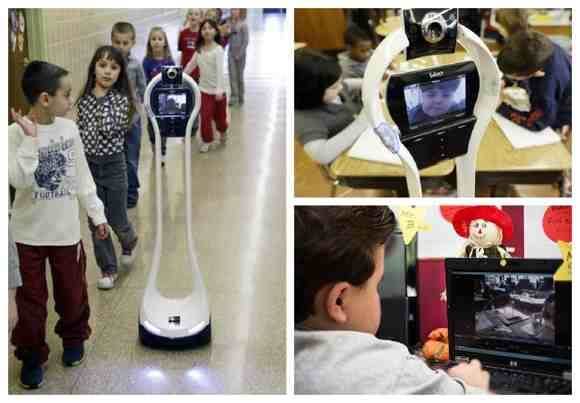Robokids – A Growing Generation Of Housebound Kids Telecommuting To School With Robots

Share
Devon Carrow was born with eosinophilic esophagitis, an allergic inflammatory disease in which white blood cells build up in the esophagus that makes exposure to common foods such as peanuts, milk and eggs life-threatening. He also has anaphylactic shock syndrome, respiratory distress syndrome and asthma. The major risk of a deadly allergic reaction had prevented him from going to school with other children and forced Devon to be home schooled – that is, until VGo came along.
VGo is a telepresence robot developed by Nashua, NH-based VGo Communcations. Since January 2012 it has enabled Devon to attend Winchester Elementary School in West Seneca, NY. He communicates wirelessly with the robot from his home five miles away, navigating it down hallways and into classrooms.
At school Devon has the job of “greeter” where he greets fellow classmates at the school’s entrance in the morning. He speaks through VGo speakers, and the teacher speaks through a microphone and amplifier so that Devon can easily hear her. And when he needs to raise his hand a light on the robot is activated. VGo can run for an entire school day without needing to be recharged – more than can be said for some students I’m sure.
As Winchester Principal Kathleen Brachmann explains, it’s a world of difference between sitting at home alone with your books and being able to participate in classroom discussion or join your friends in the hallway for lockerside chats. “Walking down a hallway, seeing other kids," she told the Washington Post, "you couldn’t expose somebody on a Skype session that way. It would just be like a TV screen. With this he really gets a feel, a sensation, of being there.”
Of course, getting around with VGo does have its extra work. Before it takes off down a hall, the Segway-looking robot lowers its camera to make sure the area in front of it is clear of objects and small people. It can sense large objects in its path and knows when it comes to a set of stairs. That’s when Devon has to wait for a teacher to lift his VGo. Luckily, the robot only weighs 18 pounds. But robots aren’t cheap. Generously, the school district is covering the $6,000 cost for VGo and the $100 per month service fees.
Be Part of the Future
Sign up to receive top stories about groundbreaking technologies and visionary thinkers from SingularityHub.



Devon Carrow uses a telepresence robot to attend school despite illnesses that keeps him at home. [Source: VgoCommunications via YouTube]
There are other children for whom telepresence robots are giving a chance to attend school they otherwise wouldn’t have. Morgan LaRue, a nine-year-old from Lovelady, Texas had undergone surgery to remove an osteosarcoma, a rare kind of bone cancer tumor that had taken form in her leg. The school provided Morgan a VGo so that she could still attend school and not have to make up all the time she would need to remain in the hospital. Another student, Lauren Robinson from Fort Collins, CO, has allergies so severe it’s dangerous for her to attend school. Instead, she also uses a VGo to roll into class, keep up with schoolwork, and be with friends. And Shelby Huff is due to receive her VGo any day now. Diagnosed with severe aplastic anemia last November, Shelby’s body is unable to produce enough new blood cells putting her at high risk for infections and uncontrolled bleeding. The 16-year-old is confined to a Ronald McDonald House for seriously ill children to receive blood transfusions twice a week. The prognosis is good – about 70 percent of aplastic anemias are cured – but in all probability Shelby won’t be able to return to school until Christmas. But the school community doesn't want to wait that long to have her back. Right now they’re busy trying to raise the money for a VGo. The Hill City High School Student Council is holding a hot dog eating contest and a walking taco feed.
Already VGos are being used by kids in New Jersey, Iowa, Wisconsin and Texas to send their personal “avatars” to school while staying safely away due to health reasons. If the rapidly growing number of telepresence robots joining the market is any indication, the number of children telecommuting through robots is likely to increase in the near future. Not to be confined to the classroom, physicians are also already using telepresence robots to be in two places at once and check up on patients that are miles away.
As yet, costs are too high right now for the robots to become a widespread solution, but no doubt more mobile avatars will be scooting down school hallways and hospitals in the future as costs go down. It’s possible that at some point even perfectly healthy and able students may be given the choice to telecommute just because they want to, or they’ll use the robots to participate in some overseas exchange program. As the students who've already had their lives enriched by the robots I'm sure feel, the sky's the limit.
Peter Murray was born in Boston in 1973. He earned a PhD in neuroscience at the University of Maryland, Baltimore studying gene expression in the neocortex. Following his dissertation work he spent three years as a post-doctoral fellow at the same university studying brain mechanisms of pain and motor control. He completed a collection of short stories in 2010 and has been writing for Singularity Hub since March 2011.
Related Articles

These Robots Are the Size of Single Cells and Cost Just a Penny Apiece

Hugging Face Says AI Models With Reasoning Use 30x More Energy on Average

Study: AI Chatbots Choose Friends Just Like Humans Do
What we’re reading
